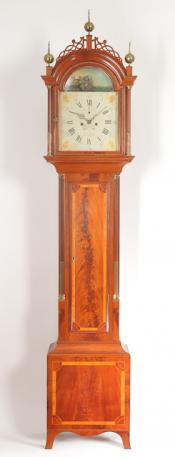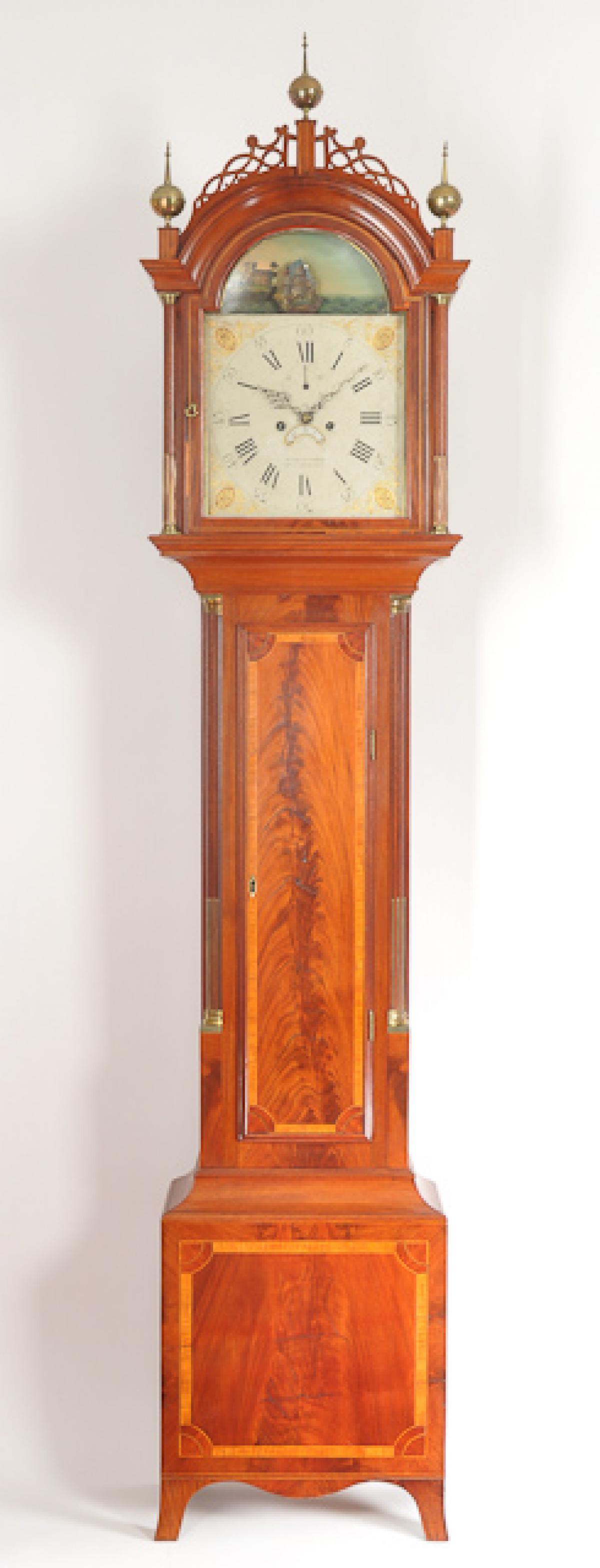William Cummens of Roxbury, Massachusetts. An inlaid mahogany case tall clock with automated rocking ship dial of Boston origin. 214103.
This is an outstanding example. It features line inlays, cross-banding, and highly figured mahogany veneers. This tall case exhibits excellent proportions, superb wood selections, and a painted rocking ship dial that is signed by the Roxbury, Massachusetts clockmaker, William Cummens.
William Cummens was born in 1768 and died on April 20, 1834, at the age of 66. He worked in Roxbury from 1789 through 1834. Along with Elnathan Taber, Simon Willard trained William Cummens as a clockmaker. After serving his apprenticeship, Cummens stayed in Roxbury and made many clocks. He had direct access to the same suppliers the Willards used, such as case makers and dial painters like Spencer Nolen. As a result, Cummens' clocks are very similar in form. Over the last 48 years in business, we have owned and sold many tall case clocks, Massachusetts shelf clocks, and wall timepieces made by this Maker.
This is a very handsome example. The case exhibits excellent choices of mahogany, mahogany veneers, and satinwood banding. All of these were selected for their strong grain pattern and formatted in a manner to command your attention. This case stands on four flared French feet. They exhibit excellent height, and the front two smoothly transition into a drop apron that hangs from the center of the base panel. The feet and apron are visually separated from the base with a line inlay pattern. The base panel features a cross-banded framing. This leads to an interesting inlay pattern. The lightly colored banded terminates at the quarter fans positioned in each corner. All of which frame the vertically positioned crotch veneer pattern located in the canter of the base. This pattern is repeated in the long rectangular-shaped waist door. This door is also trimmed with an applied molding. Through this door, one can gain access to the original green-painted tin can weights and the brass-faced pendulum bob. The bob is supported by a metal rod. On the back of this door is a partial set-up label. Brass-stopped fluted quarter columns flank the waist. These terminate in brass quarter capitals. The bonnet columns are also stopped-fluted with brass and are fitted into brass capitals. These visually support the molded arch. Above this is a pierced and open fretwork design. It is a traditional New England style pattern incorporating three brass ball and spiked finials that are mounted on line inlaid chimney plinths. The arched bonnet door is double-line inlaid and is fitted with glass. It opens to access the painted iron dial.
This 13-inch iron dial was painted in Boston, and the artwork is attributed to Spencer Nolen and Samuel Curtis. It is interesting to note that this dial does not incorporate a false plate. This implies that it was on hand when the clockmaker was making the clockworks. The four spandrel areas are decorated with lacy designs that frame a medallion in the center. The designs are highlighted in gilt paint. The time ring is formatted in a traditional display. The hours are marked in Roman numerals, and the five-minute markers are painted in Arabic. A coastal scene is painted in the arch of this dial. This arch is slightly concave. This provides the space for the automated ship to move in front of the painted scene. The motion of the pendulum automates this sailing ship. As a result, it will gently rock side to side with the pendulum's motion. This automated display is a very desirable feature. The ship is depicted at sail, flying an American Flag. The Maker signs this dial: "WARRANTED BY / W. CUMMENS." This block letter signature can be plainly seen within the time track below the calendar aperture.
This fine movement is constructed in brass and is of good quality. Four-turned pillars support the two brass plates. Hardened steel shafts support the polished steel pinions and brass gearing. The winding drums are grooved. The escapement is designed in a recoil format. The movement is weight driven and designed to run for eight days on a full wind. It is a two-train or a time-and-strike design having a rack and snail striking system. As a result, it will strike each hour on the hour. This is done on a cast iron bell which is mounted above the movement.
This clock was made circa 1795 and stands approximately 8 feet 1 inch tall or 97 inches tall, 21 inches wide, and 10 inches deep.
Inventory number 214103.
William Cummens was born in 1768 and died in Roxbury, Massachusetts, on April 20, 1834. He was 66 years old. William worked in Roxbury as a clockmaker as early as 1789. He learned clockmaking from Simon Willard. In fact, he was an apprentice in Willard's shop about the same time that Elnathan Taber was training. After serving his apprenticeship, Cummens stayed in Roxbury and worked alongside the Willard clockmaking family for many years. Based on the large number of clocks that have survived, Cummens and the Willards must have had an excellent relationship with one another. In this Roxbury location, Cummens had direct access to the same suppliers, such as case makers and dial painters, that the Willard family used. As a result, his clocks are nearly identical in form. Cummens was one of the first persons authorized by Simon Willard to manufacture Simon Willard's Patented Timepiece. The patent was granted in 1802. Over the past 55-plus years of buying and selling clocks, we have owned and sold a substantial number of tall case clocks, Massachusetts shelf clocks, and wall timepieces signed by this important clockmaker.








